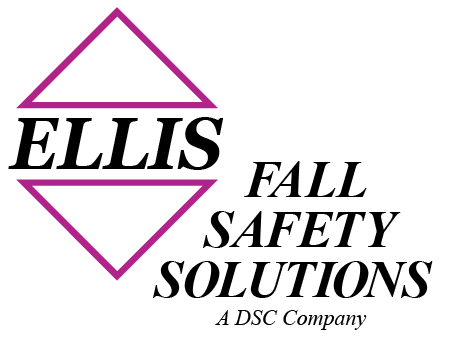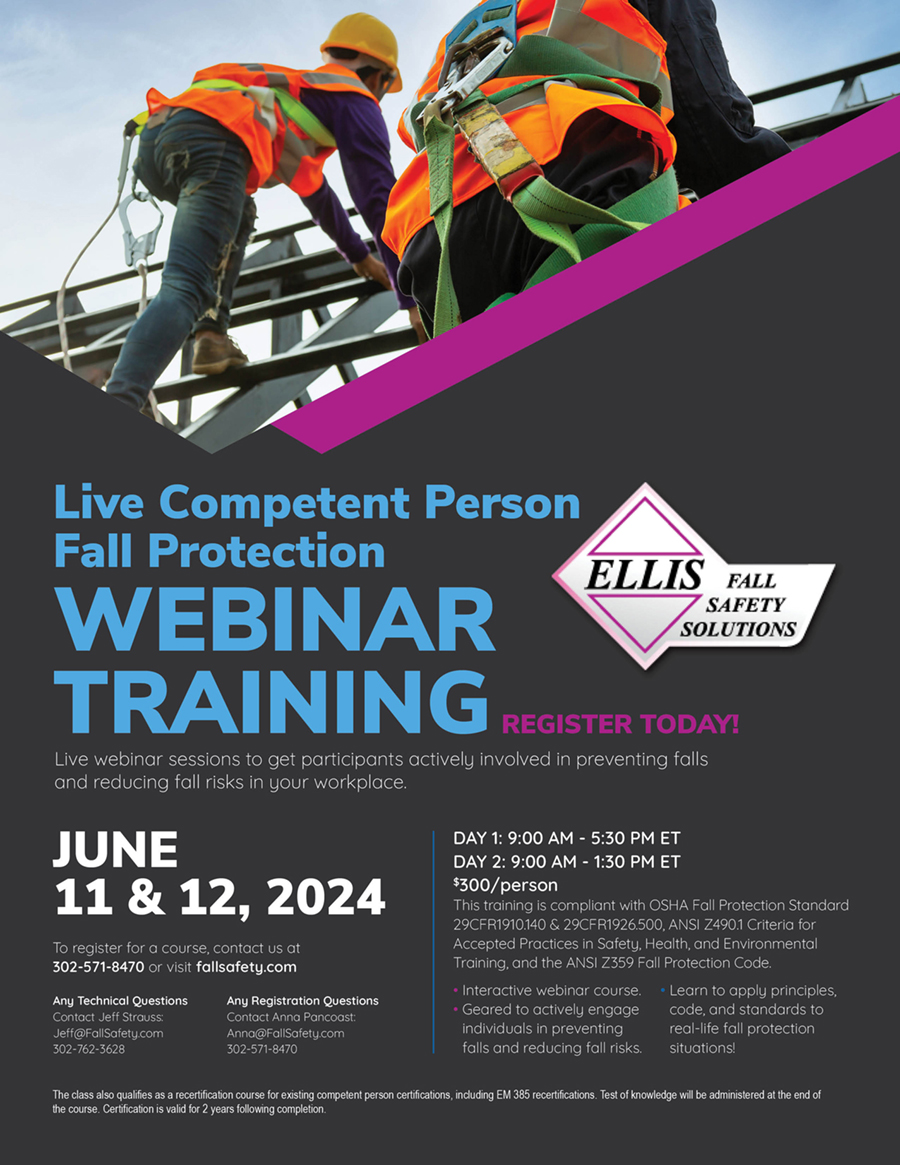Tip of the Week No. 243 – 04/06/09 – Tying Off
Question: I have what I think is a basic question on fall protection.
I’ve spent time looking at regulations on the Internet for requirements
and information on tie-off techniques. There’s lots of don’ts, but I
was unable to find any clear information on how to properly tie off. I
am aware that looping a cross-arm strap around and H or I beam provides
good anchorage, but I’d like to know about other common ways to properly
tie off.
Answer: Tie-off is a slang term which refers to a makeshift anchor
for a lifeline or lanyard system whose sole criteria is the decision of
an exposed worker.
The term Anchor means an engineered anchor and relates to an engineering
drawing that confirms the anchorage connector (e.g. axial eyebolt or
cinched strap) strength of 5,000 lbs or other strength as determined by
a Qualified Person (Z359.1).
The ANSI Z359.2 standard describes requirements for anchor points. A
future Z359 standard will refer to Horizontal Lifelines (HLL) and Rails.
Presently there is a CSA standard and EN standard for the HLL.
Fall Protection is not PPE beyond the harness. It is an engineered
system based on engineering principles to absorb the forces of
deceleration.
Asking a worker to find an anchor which is 5,000 lbs is not fair to the
equipment user. A large beam may appear to be 5000 lbs but no-one can
tell without an engineer’s calulation or template sketch communication
for similar anchors. An anchor point should always be over head height. To go less means a free fall using a 6 ft lanyard.
The subject of pre-planning involves predicting where anchors should be
located. Rescue planning requires the same for likely rescues and rescue
practice sessions after designating and constructing Rescue Anchors.
To find out more see “Introduction to Fall Protection, 3rd Edition”.
This book is an invaluable resource for every safety manager’s library. Click here to find out about ordering a copy. Order online now.
Tip of the Week No. 217 – 09/01/08 – Tying Off
Tying off, as it appears in standards as well as company policies and rules, has lulled principals, contractors, and employees into feeling comfortable with this partial form of safety.
A tie-off fall protection program also gives a company a false sense of security because managers believe fall hazards have been fully addressed, and workers simply use what is given to them.
See “Introduction to Fall Protection, 3rd Edition” page 293.
This book is an invaluable resource for every safety manager’s library. Click here to find out about ordering a copy. Order online now.
Tip of the Week No. 10 A – 02/09/04 Tying Off
Q. What’s wrong with tying off?
A. It means that untested, understrength anchorage points may be used and that workers must judge the strength of any object.
See “Introduction to Fall Protection, 3rd Edition” page 67.
How about ordering a copy of for yourself? Order online now.
Tip of the Week No. 11 A – 02/16/04 Tying Off
Q. What’s wrong with tying off?
A. It means that the shape, sharpness and contour of the tie-off points can set up a cutting action, which can be instanteous and catastrophic in some falls.
See “Introduction to Fall Protection, 3rd Edition” see page 67.
How about ordering a copy of for yourself? Order online now.
Tip of the Week No. 12 A – 02/23/04 Tying Off
Q. What’s wrong with tying off?
A. It invariably means that the fall protection equipment must be wrapped around a structural member and then attached back to itself – a method rejected by fall equipment manufacturers, and one that also restricts mobility.
See “Introduction to Fall Protection, 3rd Edition” page 67.
How about ordering a copy of for yourself? Order online now.
Tip of the Week No. 13 A – 03/01/04 Tying Off
Q. What’s wrong with tying-off?
A. It encourages the use of knots in rope lifelines and lanyards as a means of securing, but in actuality bend knots can considerably reduce the rope’s strength.
See “Introduction to Fall Protection, 3rd Edition” – page 67.
How about ordering a copy of for yourself? Order online now.
Tip of the Week No. 9 A – 02/02/04 Tying Off
Q.What’s wrong with tying off?
A. By definition it means that a worker is exposed to a fall both before and after tying off.
See “Introduction to Fall Protection, 3rd Edition” page 67.
How about ordering a copy of for yourself? Order online now.
Tip of the Week No. 271 – 02/08/10 – Tying Off
Tying off, as it appears in standards as well as in company policies and rules, has lulled principals, contractors and employees into feeling comfortable with this partial form of safety. A tie-off fall protection program also gives a company a false sense of security because mananagers believe fall hazards have been fully addressed, and workers simply use what is given to them.
See “Introduction to Fall Protection, 3rd Edition” page 293.
This book is an invaluable resource for every safety manager’s library. Click here to find out about ordering a copy. Order online now.
Tip of the Week No. 284 – 06/14/10 – Tying Off
“Obstruction considerations” – The location of the tie-off should also consider the hazard of obstructions in the potential fall path of the employee. Tie-offs which minimize the possibilities of exaggerated swinging should be considered.
In addition, when a body belt is used, the employee’s body will go through a horizontal position to a jack-knifed position during the arrest of all falls. Thus, obstructions which might interfere with this motion should be avoided or a severe injury could occur.
See “Introduction to Fall Protection, 3rd Edition” page 372.
This book is an invaluable resource for every safety manager’s library. Click here to find out about ordering a copy. Order online now.
Tip of the Week No. 298 – 10/18/10 – Tying Off
Q. What’s wrong with tying off?
A. It means that untested, understrength anchorage points may be used and that workers must judge the strength of any object.
See “Introduction to Fall Protection, 3rd Edition” page 67.
This book is an invaluable resource for every safety manager’s library. Click here to find out about ordering a copy. Order online now.
Tip of the Week No. 309 – 02/07/2011 – Tying Off
Tie-off where the line passes over or around rough or sharp surfaces reduces strength drastically. Such a tie-off should be avoided or an alternative tie-off rigging should be used. Such alternatives may include use of a snaphook/D-ring connection, wire rope tie-off, an effective padding of the surfaces, or an abrasion-resistance strap around or over the problem surface.
See “Introduction to Fall Protection, 3rd Edition” page 370.
This book is an invaluable resource for every safety manager’s library. Click here to find out about ordering a copy. Order online now.
Please select a category from the list below
- Aerial Lifts/Platforms
- Anchorage Points
- Calculations
- Construction Contracts
- Consulting
- Cranes
- Descent Devices
- Ellis Articles
- Ellis Presentations
- Equipment Maintenance
- Ergonomics/Human Factors
- Fall/Safety Statistics
- FP systems, programs
- Guardrails
- Harnesses, FP Equipment, HLL, SRL
- Hazards
- Holes/Pits
- Ladders
- Lanyards/Twin Tail Lanyards
- Misc.
- Nets
- New
- NIOSH
- OSHA News/Citations
- PFAS
- Rescue
- Roofs
- Ropes
- Safety Cases
- Safety Organizations
- Scaffolds
- Skylights
- Stairs
- Standard/Regulations
- Steel Erection
- Tanks
- Towers
- Training
- Tree Stands
- Trucks
- Tying Off
- Veterans of Safety
- Window Cleaners
- Workers Comp

